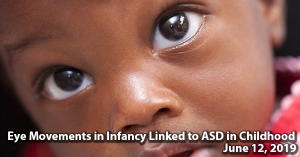Archives
June, 2019
Select a different month in the archive
Eye-Tracking Study in Infants Finds Pattern for ASD
By Chelsea Toledo, M.A. on June 12, 2019

Background: Autism spectrum disorder (ASD) is characterized by differences in communication, social interaction and behavior. Although the average age for a child to receive an ASD diagnosis is 4 years old, researchers have uncovered patterns in infants and toddlers who go on to be diagnosed. One potential indicator among the youngest children is differences in visual attention, or gaze.
What’s New: A recent study identified patterns in the joint attention – the process of looking at something alongside another person – among 10-month-old infants. The researchers conducted a series of tasks with 112 infants, 81 of whom had older siblings with ASD. Tasks were designed to assess the infants’ response to cues for joint attention (such as turning to look at a puppet), as well as how the infants initiated joint attention themselves (such as giving the infant an opportunity to point at flashing lights).
Repeating the assessments at 14 and 18 months and following up at 36 months, the researchers found:
- 22 of the children whose older siblings had ASD were later diagnosed, as well.
- Responses to cues for joint attention were not linked to rates of ASD diagnoses, but were linked to familial risk (i.e., infants who had older siblings with ASD were more likely to have low scores on this task, whether or not they were ultimately diagnosed themselves).
- The infants’ tendency to initiate joint attention was markedly different among those ultimately diagnosed with ASD, who had both lower scores in this area and atypical development of this skill between 10 and 18 months.
Why it’s important: This study suggests observable indicators of ASD may appear as early as 10 months of age. Future research could lead to earlier diagnosis and intervention.
Help me understand :
| Source(s) : |
| Tweet |

